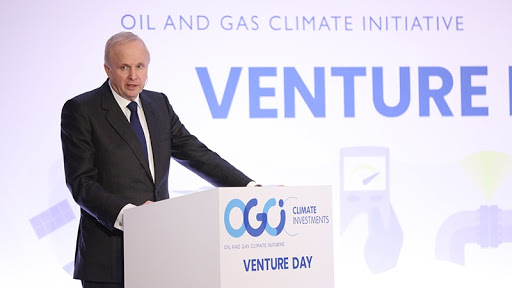Oil and Gas Climate Initiative (OGCI) members have jointly agreed to reduce their greenhouse gas emissions to not more than 21 kilograms of carbon dioxide equivalent (COE) per barrel of oil equivalent (BOE) by 2025, from 23 kilograms in 2017.
The OGCI’s 12 members, which account for over 30 percent of the global oil and gas production, are BP, Shell, Total, Chevron, Saudi Aramco, Occidental Petroleum, Petrobras, Repsol, Eni, Equinor, Exxon, and CNPC.
According to OGCI Chairman and former BP CEO Bob Dudley, members decided on a methodology to calculate carbon intensity and would keep calibrating as they go forward.
The targets would also be extended to other sectors such as refining and liquefied natural gas.
Exxon, which has resisted investor pressure to improve its disclosure on how it impacts the environment, expressed support for the OGCI targets.
Exxon did not disclose its carbon emissions in 2019.
The targets vary widely per company in scope and definition, with some exceeding the joint target.
For example, Norway’s Equinor aims to reduce its carbon dioxide intensity to below 8 kilograms of COE/BOE by 2025.
OGCI’s carbon intensity would be reported annually and reviewed by Ernst & Young as an independent third party.
The target also includes reductions in methane emissions, which the group had agreed to cut.



 Valentino Garavani Dies at 93, Leaving Behind the Timeless Legacy of Valentino Red
Valentino Garavani Dies at 93, Leaving Behind the Timeless Legacy of Valentino Red  Publishers Seek to Join Lawsuit Against Google Over Alleged AI Copyright Infringement
Publishers Seek to Join Lawsuit Against Google Over Alleged AI Copyright Infringement  China’s AI Models Narrow the Gap With the West, Says Google DeepMind CEO
China’s AI Models Narrow the Gap With the West, Says Google DeepMind CEO  BHP Posts Record Iron Ore Output as China Pricing Pressures Loom
BHP Posts Record Iron Ore Output as China Pricing Pressures Loom  Proposed Rio Tinto–Glencore Merger Faces China Regulatory Hurdles and Asset Sale Pressure
Proposed Rio Tinto–Glencore Merger Faces China Regulatory Hurdles and Asset Sale Pressure  Google Seeks Delay on Data-Sharing Order as It Appeals Landmark Antitrust Ruling
Google Seeks Delay on Data-Sharing Order as It Appeals Landmark Antitrust Ruling  Anthropic Appoints Former Microsoft Executive Irina Ghose to Lead India Expansion
Anthropic Appoints Former Microsoft Executive Irina Ghose to Lead India Expansion  Toyota Industries Buyout Faces Resistance as Elliott Rejects Higher Offer
Toyota Industries Buyout Faces Resistance as Elliott Rejects Higher Offer  Micron to Buy Powerchip Fab for $1.8 Billion, Shares Surge Nearly 10%
Micron to Buy Powerchip Fab for $1.8 Billion, Shares Surge Nearly 10%  Tesla Revives Dojo Supercomputer Project With AI5 Chip at the Core
Tesla Revives Dojo Supercomputer Project With AI5 Chip at the Core  Federal Judge Clears Way for Jury Trial in Elon Musk’s Fraud Lawsuit Against OpenAI and Microsoft
Federal Judge Clears Way for Jury Trial in Elon Musk’s Fraud Lawsuit Against OpenAI and Microsoft  BYD Shares Rise in Hong Kong on Reports of Battery Supply Talks With Ford
BYD Shares Rise in Hong Kong on Reports of Battery Supply Talks With Ford  TikTok Expands AI Age-Detection Technology Across Europe Amid Rising Regulatory Pressure
TikTok Expands AI Age-Detection Technology Across Europe Amid Rising Regulatory Pressure  Walmart International CEO Kathryn McLay to Step Down After Two and a Half Years
Walmart International CEO Kathryn McLay to Step Down After Two and a Half Years  Baidu Shares Rise in Hong Kong After Apollo Go Robotaxi Launch in Abu Dhabi
Baidu Shares Rise in Hong Kong After Apollo Go Robotaxi Launch in Abu Dhabi  Syrah Resources and Tesla Extend Deadline on Graphite Supply Dispute to March
Syrah Resources and Tesla Extend Deadline on Graphite Supply Dispute to March  TSMC Shares Hit Record High as AI Chip Demand Fuels Strong Q4 Earnings
TSMC Shares Hit Record High as AI Chip Demand Fuels Strong Q4 Earnings 






























